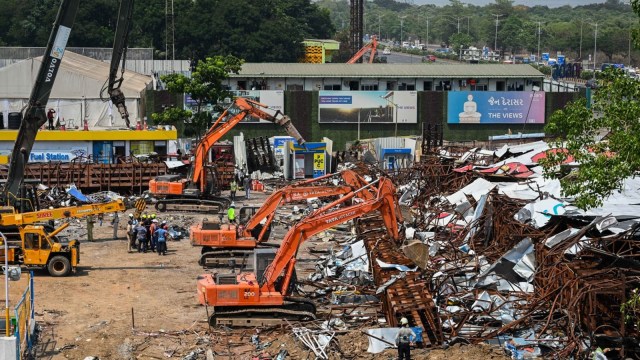Ghatkopar hoarding collapse: BMC’s hoarding policy has remained unchanged in last 16 years
Presently, the city boasts 1025 licensed hoardings, contributing a revenue of Rs. 100 crore to the BMC. These hoardings operate under guidelines outlined in the BMC's 2008 document titled 'Guidelines for permitting display of advertisements and similar signs'
 The 2008 policy guidelines outline a comprehensive set of rules that serve as the basis for the issuance of licences for hoarding installations in Mumbai. (Express Photo by Sankhadeep Banerjee)
The 2008 policy guidelines outline a comprehensive set of rules that serve as the basis for the issuance of licences for hoarding installations in Mumbai. (Express Photo by Sankhadeep Banerjee)Mumbai’s skyline is punctuated by over a thousand hoardings. These towering structures, strategically positioned along the city’s major roads, are subject to regulations established by the Brihanmumbai Municipal Corporation (BMC) back in 2008. Surprisingly, these regulations have remained unchanged for the past sixteen years, despite the evolving landscape of the city. Notably, the BMC has not suspended any licences of these hoarding operators for violations in the past few years.
Presently, the city boasts 1025 licensed hoardings, contributing a revenue of Rs. 100 crore to the BMC. These hoardings operate under guidelines outlined in the BMC’s 2008 document titled ‘Guidelines for permitting display of advertisements and similar signs’. The guidelines, initially intended for periodic reassessment due to the city’s dynamic demographic changes, have unfortunately been neglected by the BMC, failing to undergo any evaluation over the past decade.
WHAT DO THE 2008 GUIDELINES STATE
The 2008 policy guidelines outline a comprehensive set of rules that serve as the basis for the issuance of licences for hoarding installations in the city. According to these guidelines, an agency must obtain approval from a licensed structural engineer of the government or the municipal corporation before erecting a hoarding. In cases where the hoarding is intended for installation on a building, the rules mandate a structural audit of the building.
Additionally, the 2008 guidelines impose a maximum size limit of 40 * 40 feet for billboards. Senior civic officials indicate that these dimensions were determined through an analysis of factors such as maximum wind speeds, geological strata, and other relevant parameters characteristic of a coastal city.
HAVE THE GUIDELINES BEEN REVIEWED
The BMC’s hoarding guidelines mandate a review every ten years. According to this rule, the 2008 guidelines were due for revision in 2018. However, while a revised draft was prepared, its implementation was delayed due to the COVID-19 pandemic in 2020.
“A revised policy with some changes was drafted in 2018 to meet the ten-year review requirement,” explained a senior official from the licence department to The Indian Express. “However, the COVID-19 pandemic stalled its implementation, and the 2008 policy remains in effect.”
While a full policy revision was on hold, the BMC issued a circular in 2022 that modified the existing 2008 guidelines.This circular introduced key changes, including increasing the minimum distance between two hoardings from 20 metres to 70 metres and raising the maximum allowed height of a hoarding to 120 feet from the ground.
Following the recent incident in Ghatkopar, the licence department official stated, “We plan to update the policy after the elections. The new guidelines will be uploaded to our website, and we will welcome suggestions and objections from citizens before finalising and implementing the new policy.”
HAS THE BMC FLAGGED VIOLATIONS IN THE PAST
The city currently hosts 1025 hoardings, all of which have been granted licences by the BMC. Among these, 573 are illuminated, 382 are non-illuminated, and 70 are LED hoardings. In the past year, the civic licence department accrued a revenue of Rs. 179 crore, with Rs. 100 crore attributed to the 1025 licensed hoardings dispersed throughout the city.
Under the guidelines established in 2008, these 1025 licensed hoardings are mandated to undergo licence renewal every two years, necessitating structural audits conducted by accredited consultants.
However, when BMC officials were approached, they revealed that the licence department does not maintain records of revoked licences or any non-compliance by existing agencies. “We do not cancel licences outright. Instead, licensed hoardings must undergo a structural audit by an accredited body every two years. If the BMC identifies any issues during these audits, we recommend corrective actions,” explained a senior official.
In addition to the 1025 licensed hoardings, the city also accommodates 179 hoardings authorised by the Railways.
The land parcel on which the collapsed hoarding was erected is owned by Mumbai’s Collector office and is currently under the possession of Police Housing Welfare Corporation, Government of Maharashtra. The GRP is the government agency that was responsible for the plot’s maintenance.
The hoarding was found to be in violation of several norms established by the 2008 policy guidelines. “Despite the stipulated 70-metre distance between two hoardings, the distance here was less than 50 metres. Additionally, while the BMC permits a maximum hoarding size of 40×40 feet, the collapsed billboard measured 120×120 feet. Furthermore, the company failed to submit a mandatory structural stability report prior to erecting the hoarding,” revealed another senior BMC official.
Despite the guidelines outlined in 2008, which stipulate that advertisements on railway premises are subject to regulation under the provisions of the MMA Act 1888, current civic regulations do not extend to hoardings permitted by the Railways.
WHAT DO URBAN PLANNERS SUGGEST FOR BETTER REGULATION
Experts emphasised the necessity of conducting thorough structural assessments before permitting the installation of billboards in public spaces.
Alan Abraham, architect and urban planner said, “For setting up a billboard a proper study needs to be carried out to understand if the structure will be able to bear the wind-load when hoardings are erected on them. In many cases, these tests are overlooked and hoardings are being erected. Even on residential buildings we see that billboards are erected on their roof which is also not safe, because these buildings in the first place were not designed to hold so much weight on top,”
Arjun Dhawan, another urban planner, advocated for not only structural audits but also climate assessments for billboards. He pointed out the increasing intensity of storms and cyclones in Mumbai over recent years, urging consideration of such factors for citizen safety.
“In Mumbai we have seen the intensity of storms and cyclones getting increased during the past 3-4 years. In Delhi erecting large billboards were banned in 2008 after a storm had hit the city. The day the Ghatkopar mishap took place wind-speed was above 90 kmph and with time the city is experiencing frequent weather changes and the behaviour of Arabian Sea is also changing. Therefore, the requirement of having these kinds of large billboards needs to be thought about, for the safety of citizens,” Dhawan said.







